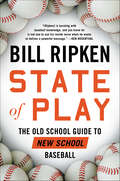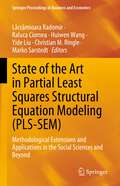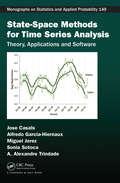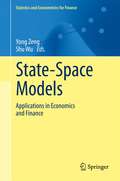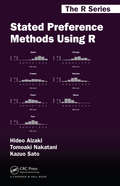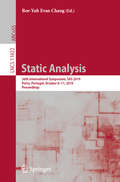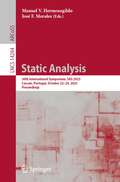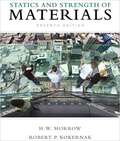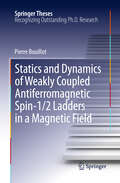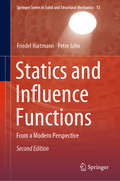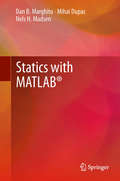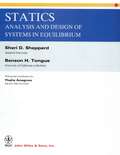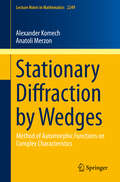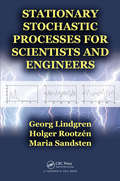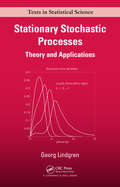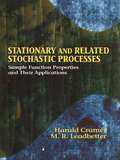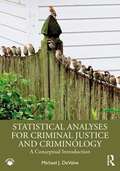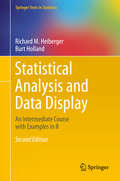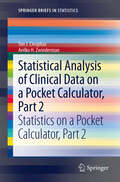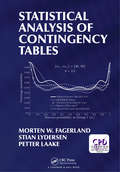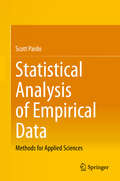- Table View
- List View
State of Play: The Old School Guide to New School Baseball
by Bill RipkenAdvanced statistics and new terminology have taken hold of baseball today, but do they accurately reflect the reality of the game? A baseball lifer states his case. America’s favorite pastime is enduring an assault of new thoughts and ideas. In recent years, the sabermetrics and analytics craze has infiltrated Major League Baseball—from its front offices to dugouts to clubhouses to media covering both, inciting a baseball culture war. New phrases like “launch angle,” “spin rate,” and “pitch framing” have entered the vocabulary, often with little real meaning when it comes to how the game is actually played on the field. No more. In State of Play, twelve-year Major League veteran, Emmy Award–winning MLB Network analyst, and bestselling author Bill Ripken breaks down these modern statistical methods to explain which ones make sense in the game’s historical context, bringing them together with proven old-school strategies. He simplifies those sabermetric terms hastily added to the baseball lexicon without being fully realized, taking new-school confusion out of old-school baseball’s tried-and-true common sense. In the end, he unites the teachings of each school to show fans of both how to listen to and understand the game as it’s played today and how it should be played moving forward. From a true baseball lifer and member of baseball’s first family, State of Play offers a fascinating insider’s look at how to reconcile years of historical tradition with the rules and trends of the new millennium. As Ripken sees it: the game inside the game cannot be measured by a spreadsheet—but it can be measured by a qualified, crusty baseball man. Play ball.
State of the Art in Partial Least Squares Structural Equation Modeling: Methodological Extensions and Applications in the Social Sciences and Beyond (Springer Proceedings in Business and Economics)
by Yide Liu Marko Sarstedt Christian M. Ringle Huiwen Wang Lăcrămioara Radomir Raluca CiorneaThis edited volume brings together some of the best papers from the 2022 Conference on Partial Least Squares Structural Equation Modeling (PLS-SEM), held at the Babeș-Bolyai University, Cluj, Romania. The volume seeks to expand the current research on PLS-SEM and promote the method’s application in the scientific community. It gathers research from scholars in many different fields who work on the advancement of PLS-SEM and who apply the method to explain and predict behavioral phenomena. Researchers today can draw on a wide array of different PLS-SEM-based algorithms, complementary methods, and model evaluation metrics. Tying in with these developments, the first part of this book documents methodological advances of PLS-SEM, which extend the researchers’ current toolbox of methods. The following parts demonstrate state-of-the-art applications of PLS-SEM in various fields such as consumer behavior, hospitality, human resource management, entrepreneurship, and organizational behavior. Special emphasis is placed on studies that apply complementary methods to offer a more nuanced analysis of the research questions.
State-Space Methods for Time Series Analysis: Theory, Applications and Software (Chapman & Hall/CRC Monographs on Statistics and Applied Probability)
by Jose Casals Alfredo Garcia-Hiernaux Miguel Jerez Sonia Sotoca A. Alexandre TrindadeThe state-space approach provides a formal framework where any result or procedure developed for a basic model can be seamlessly applied to a standard formulation written in state-space form. Moreover, it can accommodate with a reasonable effort nonstandard situations, such as observation errors, aggregation constraints, or missing in-sample values. Exploring the advantages of this approach, State-Space Methods for Time Series Analysis: Theory, Applications and Software presents many computational procedures that can be applied to a previously specified linear model in state-space form. After discussing the formulation of the state-space model, the book illustrates the flexibility of the state-space representation and covers the main state estimation algorithms: filtering and smoothing. It then shows how to compute the Gaussian likelihood for unknown coefficients in the state-space matrices of a given model before introducing subspace methods and their application. It also discusses signal extraction, describes two algorithms to obtain the VARMAX matrices corresponding to any linear state-space model, and addresses several issues relating to the aggregation and disaggregation of time series. The book concludes with a cross-sectional extension to the classical state-space formulation in order to accommodate longitudinal or panel data. Missing data is a common occurrence here, and the book explains imputation procedures necessary to treat missingness in both exogenous and endogenous variables. Web ResourceThe authors’ E4 MATLAB® toolbox offers all the computational procedures, administrative and analytical functions, and related materials for time series analysis. This flexible, powerful, and free software tool enables readers to replicate the practical examples in the text and apply the procedures to their own work.
State-Space Models: Applications in Economics and Finance
by Yong Zeng Shu WuState-space models as an important mathematical tool has been widely used in many different fields. This edited collection explores recent theoretical developments of the models and their applications in economics and finance. The book includes nonlinear and non-Gaussian time series models, regime-switching and hidden Markov models, continuous- or discrete-time state processes, and models of equally-spaced or irregularly-spaced (discrete or continuous) observations. The contributed chapters are divided into four parts. The first part is on Particle Filtering and Parameter Learning in Nonlinear State-Space Models. The second part focuses on the application of Linear State-Space Models in Macroeconomics and Finance. The third part deals with Hidden Markov Models, Regime Switching and Mathematical Finance and the fourth part is on Nonlinear State-Space Models for High Frequency Financial Data. The book will appeal to graduate students and researchers studying state-space modeling in economics, statistics, and mathematics, as well as to finance professionals.
Stated Preference Methods Using R (Chapman & Hall/CRC The R Series)
by Kazuo Sato Hideo Aizaki Tomoaki NakataniStated Preference Methods Using R explains how to use stated preference (SP) methods, which are a family of survey methods, to measure people's preferences based on decision making in hypothetical choice situations. Along with giving introductory explanations of the methods, the book collates information on existing R functions and packages as well
Static Analysis: 26th International Symposium, SAS 2019, Porto, Portugal, October 8–11, 2019, Proceedings (Lecture Notes in Computer Science #11822)
by Bor-Yuh Evan ChangThis book constitutes the refereed proceedings of the 26th International Symposium on Static Analysis, SAS 2019, held in Porto, Portugal, in October 2019. The 20 regular papers presented in this book were carefully reviewed and selected from 50 submissions. The papers are grouped in topical sections on pointers and dataflow; languages and decidability; numerical; trends: assuring machine learning; synthesis and security; and temporal properties and termination.
Static Analysis: 30th International Symposium, SAS 2023, Cascais, Portugal, October 22–24, 2023, Proceedings (Lecture Notes in Computer Science #14284)
by José F. Morales Manuel V. HermenegildoThis book constitutes the refereed proceedings of the 30th International Symposium on Static Analysis, SAS 2023, held in Lisbon, Portugal, in October 2023. The 20 full papers included in this book were carefully reviewed and selected from 40 submissions. Static analysis is widely recognized as a fundamental tool for program verification, bug detection, compiler optimization, program understanding, and software maintenance. The papers deal with theoretical, practical and application advances in the area.
Static Green's Functions in Anisotropic Media
by Ernian Pan Weiqiu ChenThis book presents basic theory on static Green's functions in general anisotropic magnetoelectroelastic media including detailed derivations based on the complex variable method, potential method, and integral transforms. Green's functions corresponding to the reduced cases are also presented including those in anisotropic and transversely isotropic piezoelectric and piezomagnetic media, and in purely anisotropic elastic, transversely isotropic elastic and isotropic elastic media. Problems include those in three-dimensional, (two-dimensional) infinite, half, and bimaterial spaces (planes). While the emphasis is on the Green's functions related to the line and point force, those corresponding to the important line and point dislocation are also provided and discussed. This book provides a comprehensive derivation and collection of the Green's functions in the concerned media, and as such, it is an ideal reference book for researchers and engineers, and a textbook for both students in engineering and applied mathematics.
Statics And Strength Of Materials
by Harold Morrow Robert KokernakSTATICS AND STRENGTH OF MATERIALS, 7/e is fully updated text and presents logically organized, clear coverage of all major topics in statics and strength of materials, including the latest developments in materials technology and manufacturing/construction techniques. A basic knowledge of algebra and trigonometry are the only mathematical skills it requires, although several optional sections using calculus are provided for instructors teaching in ABET accredited programs. A new introductory section on catastrophic failures shows students why these topics are so important, and 25 full-page, real-life application sidebars demonstrate the relevance of theory. To simplify understanding and promote student interest, the book is profusely illustrated.
Statics and Dynamics of Weakly Coupled Antiferromagnetic Spin-1/2 Ladders in a Magnetic Field
by Pierre BouillotThis thesis shows how a combination of analytic and numerical techniques, such as a time dependent and finite temperature Density Matrix Renormalization Group (DMRG) technique, can be used to obtain the physical properties of low dimensional quantum magnets with an unprecedented level of accuracy. A comparison between the theory and experiment then enables these systems to be used as quantum simulators; for example, to test various generic properties of low dimensional systems such as Luttinger liquid physics, the paradigm of one dimensional interacting quantum systems. Application of these techniques to a material made of weakly coupled ladders (BPCB) allowed the first quantitative test of Luttinger liquids. In addition, other physical quantities (magnetization, specific heat etc.), and more remarkably the spins-spin correlations - directly measurable in neutron scattering experiments - were in excellent agreement with the observed quantities. We thus now have tools to quantitatiively assess the dynamics for this class of quantum systems.
Statics and Influence Functions: From a Modern Perspective (Springer Series in Solid and Structural Mechanics #13)
by Friedel Hartmann Peter JahnThis extended and revised second edition is intended for engineering students and researchers working with finite element methods in structural and mechanical analysis. Discussing numerical structural analysis from first mechanical and mathematical principles, it establishes the central role of influence functions (Green's functions) in finite element analysis, reanalysis, sensitivity analysis, parameter identification and in optimization, with a particular focus on computational aspects and questions of accuracy. It also presents a one-click reanalysis, a new technique that allows instantaneous modifications to a structure to be made by clicking on single elements. Lastly, the book features four programs that can be downloaded for the solution of the Poisson equation, 2-D elasticity, plate-bending problems and planar frames.
Statics with MATLAB®
by Mihai Dupac Dan B. Marghitu Nels H. MadsenEngineering mechanics involves the development of mathematical models of the physical world. Statics addresses the forces acting on and in mechanical objects and systems. Statics with MATLAB® develops an understanding of the mechanical behavior of complex engineering structures and components using MATLAB® to execute numerical calculations and to facilitate analytical calculations. MATLAB® is presented and introduced as a highly convenient tool to solve problems for theory and applications in statics. Included are example problems to demonstrate the MATLAB® syntax and to also introduce specific functions dealing with statics. These explanations are reinforced through figures generated with MATLAB® and the extra material available online which includes the special functions described. This detailed introduction and application of MATLAB® to the field of statics makes Statics with MATLAB® a useful tool for instruction as well as self study, highlighting the use of symbolic MATLAB® for both theory and applications to find analytical and numerical solutions
Statics: Analysis And Design Of Systems In Equilibrium
by Sheri D. Sheppard Benson H. TongueStatics: Analysis and Design of Systems in Equilibrium, by Sheri D. Sheppard of Stanford University, and Benson H. Tongue, University of California, Berkeley, offers a student-focused approach to Statics. With a strong emphasis on drawing free body diagrams, use of a structured problem-solving methodology, inclusion of real-world case studies, and robust pedagogy coupled with a truly engaging writing style, reviewers alike have praised this new Statics text. Additionally, this first edition has benefited from a comprehensive and thorough accuracy check by 15 experienced professors, and has been reviewed by more than 200 Statics and Dynamics professors. The text seeks to improve students’ abilities to map their understanding to more realistic engineering situations, enabling them to more effectively break down complex problems into manageable parts, and thus, become more effective engineering students and ultimately, professional engineers. The authors do not compromise on rigor. Instead this series demonstrates the required rigor in the larger context of engineering work, decision making, problem solving, and understanding and impacting the man-made world.
Stationary Diffraction by Wedges: Method of Automorphic Functions on Complex Characteristics (Lecture Notes in Mathematics #2249)
by Alexander Komech Anatoli MerzonThis book presents a new and original method for the solution of boundary value problems in angles for second-order elliptic equations with constant coefficients and arbitrary boundary operators. This method turns out to be applicable to many different areas of mathematical physics, in particular to diffraction problems in angles and to the study of trapped modes on a sloping beach. Giving the reader the opportunity to master the techniques of the modern theory of diffraction, the book introduces methods of distributions, complex Fourier transforms, pseudo-differential operators, Riemann surfaces, automorphic functions, and the Riemann–Hilbert problem. The book will be useful for students, postgraduates and specialists interested in the application of modern mathematics to wave propagation and diffraction problems.
Stationary Stochastic Processes for Scientists and Engineers
by Georg Lindgren Holger Rootzen Maria SandstenSuitable for a one-semester course, this text teaches students how to use stochastic processes efficiently. Carefully balancing mathematical rigor and ease of exposition, the book provides students with a sufficient understanding of the theory and a practical appreciation of how it is used in real-life situations. Special emphasis is on the interpretation of various statistical models and concepts as well as the types of questions statistical analysis can answer. To enable hands-on practice, MATLAB code is available online.
Stationary Stochastic Processes: Theory and Applications (Chapman & Hall/CRC Texts in Statistical Science)
by Georg LindgrenIntended for a second course in stationary processes, Stationary Stochastic Processes: Theory and Applications presents the theory behind the field's widely scattered applications in engineering and science. In addition, it reviews sample function properties and spectral representations for stationary processes and fields, including a portion on st
Stationary and Related Stochastic Processes: Sample Function Properties and Their Applications
by M. Ross Leadbetter Harald CramérThis graduate-level text offers a comprehensive account of the general theory of stationary processes, with special emphasis on the properties of sample functions. Assuming a familiarity with the basic features of modern probability theory, the text develops the foundations of the general theory of stochastic processes, examines processes with a continuous-time parameter, and applies the general theory to procedures key to the study of stationary processes. Additional topics include analytic properties of the sample functions and the problem of time distribution of the intersections between a sample function. 1967 edition.
Statistical Modeling and Inference for Social Science
by Sean GailmardWritten specifically for graduate students and practitioners beginning social science research, Statistical Modeling and Inference for Social Science covers the essential statistical tools, models and theories that make up the social scientist's toolkit. Assuming no prior knowledge of statistics, this textbook introduces students to probability theory, statistical inference and statistical modeling, and emphasizes the connection between statistical procedures and social science theory. Sean Gailmard develops core statistical theory as a set of tools to model and assess relationships between variables - the primary aim of social scientists - and demonstrates the ways in which social scientists express and test substantive theoretical arguments in various models. Chapter exercises guide students in applying concepts to data, extending their grasp of core theoretical concepts. Students gain the ability to create, read and critique statistical applications in their fields of interest.
Statistical Analyses for Criminal Justice and Criminology: A Conceptual Introduction
by Michael J. DeValveThis book is a how-to guide on statistical analyses designed for undergraduates and others new to the subject. It uses a conceptual framework, starting with the most basic concepts of statistics and moving up through the capacity to perform bivariate regression.Written in an easy-going and clear style, it uses policing data to illustrate concepts. Easily identified Main Take-Aways and Key Terms features aid student understanding. Designed to combat the fear of mathematics and statistics often held by students in the social sciences, plain verbiage, multiple examples, and clear demonstrations combine to achieve the actualization and proper contextualized use of univariate and bivariate statistics. This work also serves as a launching pad for further study in statistics.As an accessible introduction to statistics in criminal justice and criminology, this text will appeal to both students and instructors in introductory criminal justice and criminology statistics courses.
Statistical Analysis and Data Display
by Richard M. Heiberger Burt HollandThis contemporary presentation of statistical methods features extensive use of graphical displays for exploring data and for displaying the analysis. The authors demonstrate how to analyze data--showing code, graphics, and accompanying tabular listings--for all the methods they cover. They emphasize how to construct and interpret graphs. They discuss principles of graphical design. They identify situations where visual impressions from graphs may need confirmation from traditional tabular results. All chapters have exercises. The authors provide and discuss R functions for all the new graphical display formats. All graphs and tabular output in the book were constructed using these functions. Complete R scripts for all examples and figures are provided for readers to use as models for their own analyses. This book can serve as a standalone text for statistics majors at the master's level and for other quantitatively oriented disciplines at the doctoral level, and as a reference book for researchers. In-depth discussions of regression analysis, analysis of variance, and design of experiments are followed by introductions to analysis of discrete bivariate data, nonparametrics, logistic regression, and ARIMA time series modeling. The authors illustrate classical concepts and techniques with a variety of case studies using both newer graphical tools and traditional tabular displays. The Second Edition features graphs that are completely redrawn using the more powerful graphics infrastructure provided by R's lattice package. There are new sections in several of the chapters, revised sections in all chapters and several completely new appendices. New graphical material includes: * an expanded chapter on graphics * a section on graphing Likert Scale Data to build on the importance of rating scales in fields from population studies to psychometrics * a discussion on design of graphics that will work for readers with color-deficient vision * an expanded discussion on the design of multi-panel graphics * expanded and new sections in the discrete bivariate statistics capter on the use of mosaic plots for contingency tables including the n×2×2 tables for which the Mantel-Haenszel-Cochran test is appropriate * an interactive (using the shiny package) presentation of the graphics for the normal and t-tables that is introduced early and used in many chapters The new appendices include discussions of R, the HH package designed for R (the material in the HH package was distributed as a set of standalone functions with the First Edition of this book), the R Commander package, the RExcel system, the shiny package, and a minimal discussion on writing R packages. There is a new appendix on computational precision illustrating and explaining the FAQ (Frequently Asked Questions) about the differences between the familiar real number system and the less-familiar floating point system used in computers. The probability distributions appendix has been expanded to include more distributions (all the distributions in base R) and to include graphs of each. The editing appendix from the First Edition has been split into four expanded appendices--on working style, writing style, use of a powerful editor, and use of LaTeX for document preparation.
Statistical Analysis in Climate Research
by Hans Von Storch Francis W. ZwiersClimatology is, to a large degree, the study of the statistics of our climate. The powerful tools of mathematical statistics therefore find wide application in climatological research. The purpose of this book is to help the climatologist understand the basic precepts of the statistician's art and to provide some of the background needed to apply statistical methodology correctly and usefully. The book is self contained: introductory material, standard advanced techniques, and the specialised techniques used specifically by climatologists are all contained within this one source. There are a wealth of real-world examples drawn from the climate literature to demonstrate the need, power and pitfalls of statistical analysis in climate research. Suitable for graduate courses on statistics for climatic, atmospheric and oceanic science, this book will also be valuable as a reference source for researchers in climatology, meteorology, atmospheric science, and oceanography.
Statistical Analysis in Forensic Science
by Grzegorz Zadora Daniel Ramos Colin Aitken Agnieszka MartynaA practical guide for determining the evidential value of physicochemical dataMicrotraces of various materials (e.g. glass, paint, fibres, and petroleum products) are routinely subjected to physicochemical examination by forensic experts, whose role is to evaluate such physicochemical data in the context of the prosecution and defence propositions. Such examinations return various kinds of information, including quantitative data. From the forensic point of view, the most suitable way to evaluate evidence is the likelihood ratio. This book provides a collection of recent approaches to the determination of likelihood ratios and describes suitable software, with documentation and examples of their use in practice. The statistical computing and graphics software environment R, pre-computed Bayesian networks using Hugin Researcher and a new package, calcuLatoR, for the computation of likelihood ratios are all explored.Statistical Analysis in Forensic Science will provide an invaluable practical guide for forensic experts and practitioners, forensic statisticians, analytical chemists, and chemometricians.Key features include:Description of the physicochemical analysis of forensic trace evidence.Detailed description of likelihood ratio models for determining the evidential value of multivariate physicochemical data.Detailed description of methods, such as empirical cross-entropy plots, for assessing the performance of likelihood ratio-based methods for evidence evaluation.Routines written using the open-source R software, as well as Hugin Researcher and calcuLatoR.Practical examples and recommendations for the use of all these methods in practice.
Statistical Analysis of Clinical Data on a Pocket Calculator, Part 2
by Aeilko H. Zwinderman Ton J. CleophasThe first part of this title contained all statistical tests relevant to starting clinical investigations, and included tests for continuous and binary data, power, sample size, multiple testing, variability, confounding, interaction, and reliability. The current part 2 of this title reviews methods for handling missing data, manipulated data, multiple confounders, predictions beyond observation, uncertainty of diagnostic tests, and the problems of outliers. Also robust tests, non-linear modeling , goodness of fit testing, Bhatacharya models, item response modeling, superiority testing, variability testing, binary partitioning for CART (classification and regression tree) methods, meta-analysis, and simple tests for incident analysis and unexpected observations at the workplace and reviewed. Each test method is reported together with (1) a data example from practice, (2) all steps to be taken using a scientific pocket calculator, and (3) the main results and their interpretation. Although several of the described methods can also be carried out with the help of statistical software, the latter procedure will be considerably slower. Both part 1 and 2 of this title consist of a minimum of text and this will enhance the process of mastering the methods. Yet the authors recommend that for a better understanding of the test procedures the books be used together with the same authors' textbook "Statistics Applied to Clinical Studies" 5th edition edited 2012, by Springer Dordrecht Netherlands. More complex data files like data files with multiple treatment modalities or multiple predictor variables can not be analyzed with a pocket calculator. We recommend that the small books "SPSS for starters", Part 1 and 2 (Springer, Dordrecht, 2010, and 2012) from the same authors be used as a complementary help for the readers' benefit.
Statistical Analysis of Contingency Tables
by Morten Fagerland Stian Lydersen Petter LaakeStatistical Analysis of Contingency Tables is an invaluable tool for statistical inference in contingency tables. It covers effect size estimation, confidence intervals, and hypothesis tests for the binomial and the multinomial distributions, unpaired and paired 2x2 tables, rxc tables, ordered rx2 and 2xc tables, paired cxc tables, and stratified tables. For each type of table, key concepts are introduced, and a wide range of intervals and tests, including recent and unpublished methods and developments, are presented and evaluated. Topics such as diagnostic accuracy, inter-rater reliability, and missing data are also covered. The presentation is concise and easily accessible for readers with diverse professional backgrounds, with the mathematical details kept to a minimum. For more information, including a sample chapter and software, please visit the authors' website.
Statistical Analysis of Empirical Data: Methods for Applied Sciences
by Scott PardoResearchers and students who use empirical investigation in their work must go through the process of selecting statistical methods for analyses, and they are often challenged to justify these selections. This book is designed for readers with limited background in statistical methodology who seek guidance in defending their statistical decision-making in the worlds of research and practice. It is devoted to helping students and scholars find the information they need to select data analytic methods, and to speak knowledgeably about their statistical research processes. Each chapter opens with a conundrum relating to the selection of an analysis, or to explaining the nature of an analysis. Throughout the chapter, the analysis is described, along with some guidance in justifying the choices of that particular method.Designed to offer statistical knowledge to the non-specialist, this volume can be used in courses on research methods, or for courses on statistical applications to biological, medical, life, social, or physical sciences. It will also be useful to academic and industrial researchers in engineering and in the physical sciences who will benefit from a stronger understanding of how to analyze empirical data. The book is written for those with foundational education in calculus. However, a brief review of fundamental concepts of probability and statistics, together with a primer on some concepts in elementary calculus and matrix algebra, is included. R code and sample datasets are provided.
